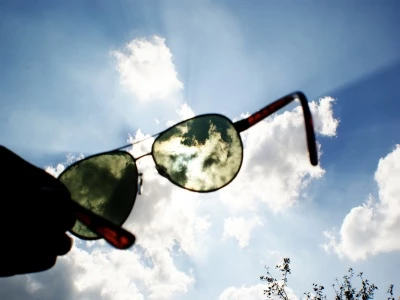Choosing the right sunglasses
Once upon a time, choosing which sunglasses lens to buy was pretty straightforward, but the sheer range and variety of options available today mean taking a long, hard look before making that crucial choice.
Sunglass lens technology has come a long way in recent years, and new materials are always coming onto the market with significant advances in lens coatings.
Tinted lenses come in many colours, each with advantages and drawbacks in different lighting conditions.
Enhancements can include gradient tinting to help make lenses more dual-purpose and photochromic lenses that change shade to match various lighting levels.
Polarised lenses and specialist coatings increase the range and effectiveness of sunglass lens tints.
Tinted lenses can enhance vision
Tinted lenses are often the most straightforward choice, and cosmetics will play a big part in your chosen lens shade. It is merely a matter of selecting the colour and tone depth that suits you best. But there are some other considerations to take into account here. Much depends on the conditions in which you expect to wear sunglasses. Bright sunlight is the obvious candidate here, but this is only sometimes the case. Individual colours can enhance vision in certain conditions, and the choice may not be dependent only on cosmetics. A light blue tint, for example, may look good outdoors, but it is not OK when glare is a factor, such as when sailing and water is reflected upwards off the surface.
A blue-tinted sunglasses lens can even increase glare in the big outdoors, so choose this tint mainly as a fashion item for streetwear and the city. For general outdoor holiday wear, brown-tinted sunglasses often make the best choice. Brown filters out the blue glare from water and sky and can increase contrast, so brown-coloured lenses are suitable for general outdoor use. Brown is a popular choice for standard holiday sunglasses.
Neutral grey is a popular choice
Grey is an excellent alternative to brown, retaining decent colour differential and reducing outdoor glare. Thus, a neutral grey tone is usually the most popular choice for the big outdoors and night driving. Many also prefer a green-tinted sunglasses lens. Green tint lenses tend to be darker and favoured by those with sensitive eyes. They can give the highest contrast and the right colour balance despite blocking out plenty of glare. Yellow and orange tints are the most popular choice for those who are into snow sports, such as skiing and snowboarding. Yellow tint sunglasses will soften the harsh white-blue light of pure snow while simultaneously increasing colour contrast and depth perception. Pink and rose-tinted sunglasses can help relieve eyestrain and are often used by people at computer screens. Colour perception may not be as accurate as other tints.
Graduated tints for reading
Many sunglasses carry a graduated tint in any of the above colours. The colour is strongest at the top of the lens with graduated tones and gets progressively less tinted until it is pretty clear. Graduated tint lenses are suitable for reading or carrying out tasks requiring clarity when looking downwards but plenty of shade when the eyes are raised.
Photochromic get a reaction
This type of sunglasses lens has a special coating that reacts to sunlight. Often referred to as transition lenses, they become automatically darker as you move into the bright light and lighten when you head out of the sun. The reaction time of photochromic lenses can vary, but the transition usually gets underway in less than 60 seconds. They continue to get darker or lighter for several minutes until reaching the optimum tint for the lighting conditions. The coating is usually activated by ultraviolet light, which is, in fact, invisible, so the darkening and lightening effect happens even on cloudy days and depends only on the amount of UV light that hits the lenses. Photochromic lenses usually retain a small degree of tint, even in dark conditions. They can be handy for those moving about in varying light conditions, such as indoors and outdoors, but they are not much used for driving as headlights pass too quickly for them to react. Even in daylight, the car windscreen may itself block UV light, so the photochromic lenses may be nowhere near as efficient when behind the wheel.
Polarised lenses cut out glare
Popular with drivers and sailors, polarised lenses are particularly useful in eliminating glare from large surfaces such as the sea and sky but with little or no loss of definition. Unlike standard tint lenses that reduce light at any angle, polarised lenses will cut out light waves travelling horizontally but let vertical light waves pass through. Polarisation only reduces glare but also improves both depth and colour perception. Vertically aligned light is more visually critical than horizontal rays, the central component of glare. The sun's glare on the sea and other flat surfaces can be highly polarised and, in some conditions, almost entirely horizontally polarised. Likewise, the most reflected light is horizontal, and images appear clearer with this filtered out by polarised sunglasses.
Polarised sunglasses are especially suitable for driving as the light from bright reflections, and the road surface tends to be horizontally polarised. Polarising lenses give higher-definition vision for driving, removing the effect of dazzle and reducing eyestrain.
Take care, however, when choosing polarised lenses. Cheap polarised lenses tend to cut out less light, some as little as 10%. High-quality polarised lenses will filter out more than 90% of the horizontal light.
Related Articles
UV shades are good for you
Sunglasses for the slopes
Give up on scratched lenses
Cleaning your lenses


